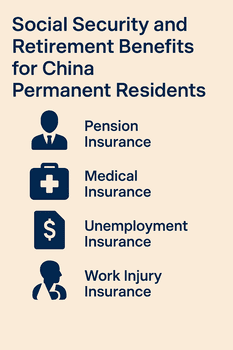
China’s social security system has undergone significant reforms in recent years, with important implications for permanent residents.
This comprehensive guide explores the current social security and retirement benefits available to China Permanent Residents in 2025, providing detailed information on contribution requirements, benefit calculations, and practical considerations for long-term planning.
Understanding China’s Social Security Framework
China’s social security system consists of five mandatory insurance programs plus a housing fund, collectively known as the “5+1” system.
For permanent residents, participation in this system provides essential protections while working and during retirement.
The Five Pillars of China’s Social Security System
| Insurance Type | Purpose | Coverage | Contribution Source |
|---|---|---|---|
| Pension Insurance | Retirement income | Monthly payments based on contributions and years of service | Employer and employee |
| Medical Insurance | Healthcare costs | Coverage for inpatient and outpatient services | Employer and employee |
| Unemployment Insurance | Income during job transitions | Temporary financial support when unemployed | Employer and employee |
| Work-Related Injury Insurance | Workplace accident coverage | Medical expenses and disability benefits | Employer only |
| Maternity Insurance | Childbirth expenses and leave | Medical costs and salary during maternity leave | Employer only (often combined with medical insurance) |
Source: MSA Advisory
Housing Fund
While not technically part of social security, the housing fund is an important component of China’s social welfare system:
- Contributions from both employer and employee (typically 5-12% of salary)
- Funds can be used for home purchases, renovations, or rent
- Accessible upon retirement or when leaving China permanently
Current Contribution Rates and Thresholds (2025)
Contribution rates vary significantly by location. The table below shows current rates in major cities:
| City | Pension | Medical | Unemployment | Work Injury | Maternity | Total Employee | Total Employer |
|---|---|---|---|---|---|---|---|
| Shanghai | 8% | 2% | 0.5% | 0% | 0% | 10.5% | 25.66-27.02% |
| Beijing | 8% | 2% | 0.5% | 0% | 0% | 10.5% | 26.5-28.2% |
| Guangzhou | 8% | 2% | 0.2% | 0% | 0% | 10.2% | 21.35-22.55% |
| Shenzhen | 8% | 2% | 0.3% | 0% | 0% | 10.3% | 20.3-21.3% |
Source: PwC China Tax Summaries
Contribution Caps (2025)
Contributions are calculated based on salary but are subject to caps:
- Minimum base: 60% of average local monthly salary
- Maximum base: 300% of average local monthly salary
For example, in Shanghai, the contribution cap is CNY 36,921 per month as of December 2024, meaning that’s the maximum salary amount used to calculate contributions regardless of actual salary.
Eligibility Requirements for Permanent Residents
Mandatory Participation
As of 2025, permanent residents in China are required to participate in the social security system, with some exceptions based on totalization agreements.
Totalization Agreements
China currently has totalization agreements with eleven countries that allow citizens of these countries to be exempt from certain social security contributions in China:
| Country | Effective Date | Exempted Items |
|---|---|---|
| Germany | April 4, 2002 | Pension and Unemployment |
| South Korea | January 16, 2013 | Pension and Unemployment |
| Denmark | May 14, 2014 | Pension |
| Canada | January 1, 2017 | Pension |
| Finland | February 1, 2017 | Pension and Unemployment |
| Switzerland | June 19, 2017 | Pension and Unemployment |
| Netherlands | September 1, 2017 | Pension and Unemployment |
| Spain | March 20, 2018 | Pension and Unemployment |
| Luxembourg | May 1, 2019 | Pension |
| Japan | September 1, 2019 | Pension |
| Serbia | February 1, 2021 | Pension and Unemployment |
Source: PwC China Tax Summaries
A totalization agreement with France has been signed but is not yet in force as of early 2025.
Pension Benefits for Permanent Residents
Qualifying for a Chinese Pension
To qualify for pension benefits in China, permanent residents must meet these key requirements:
- Minimum contribution period: 15 years of contributions to the Chinese pension system
- Retirement age: Currently 60 for men, 55 for women in white-collar positions, and 50 for women in blue-collar positions
- Application process: Must apply through the local Social Insurance Bureau
Important: China is gradually implementing a retirement age reform plan that will incrementally increase the retirement age to 65 for men and 60 for women by 2035. Permanent residents should stay informed about these changes.
As confirmed by Justin 王大海 from 5SC WeChat group: The Social Security contribution cap extends 3 years beyond retirement age for those assessing if they have enough time to meet the required years.
Pension Calculation Formula
The Chinese pension consists of two components:
- Basic Pension: Approximately 1% of the average local salary for each year of contribution
- Individual Account Pension: Monthly payment calculated by dividing accumulated individual account balance by a factor based on retirement age and life expectancy
For example, a permanent resident who contributed for 20 years in Shanghai with an average salary of CNY 15,000 might receive:
- Basic pension: Approximately CNY 3,000 per month
- Individual account pension: Approximately CNY 1,500 per month
- Total monthly pension: Approximately CNY 4,500
Pension Portability
For permanent residents who leave China before qualifying for a pension:
- With less than 15 years of contributions: Can apply for a lump-sum refund of their individual account
- With 15+ years of contributions: Can either maintain the account until retirement age or transfer benefits if covered by a totalization agreement
Medical Insurance Benefits
Coverage Scope
Permanent residents enrolled in China’s medical insurance system receive:
- Inpatient coverage: 70-90% of costs depending on hospital tier
- Outpatient coverage: 50-70% of costs after meeting deductibles
- Prescription medications: Coverage for medications on the National Reimbursement Drug List
- Preventive care: Annual physical examinations and certain vaccinations
Regional Variations
Medical benefits vary significantly by location:
| City | Inpatient Reimbursement Rate | Annual Reimbursement Cap | Outpatient Deductible |
|---|---|---|---|
| Shanghai | 85-95% | CNY 650,000 | CNY 1,800 |
| Beijing | 80-90% | CNY 600,000 | CNY 1,800 |
| Guangzhou | 75-90% | CNY 550,000 | CNY 1,500 |
| Shenzhen | 80-95% | CNY 600,000 | CNY 1,300 |
Source: Local Social Insurance Bureau regulations as of January 2025
Supplementary Medical Insurance
Many permanent residents opt for supplementary commercial health insurance to cover:
- Higher-tier hospitals
- VIP services
- International medical evacuation
- Coverage gaps in the public system
Unemployment and Work Injury Benefits
Unemployment Insurance
Eligible permanent residents can receive:
- Monthly payments of 70-80% of local minimum wage
- Duration of 12-24 months depending on contribution history
- Job placement assistance
- Skills training subsidies
Work Injury Insurance
Benefits include:
- 100% coverage for work-related medical expenses
- Disability allowances based on injury severity
- Rehabilitation services
- Survivor benefits in case of work-related death
Maternity Benefits
Female permanent residents covered by maternity insurance receive:
- Medical costs for prenatal care, delivery, and postnatal care
- Maternity leave salary (typically 100% of average monthly salary)
- Maternity leave duration (98 days standard, with extensions in certain circumstances)
Social Security Registration Process
Required Documents for Permanent Residents
- Permanent Residence Card
- Valid passport
- Employment contract (if employed)
- Residence registration from local police
- Recent photographs
Registration Steps
- Employer registration: For employed permanent residents, the employer handles registration
- Self-registration: Self-employed permanent residents must register directly with the local Social Insurance Bureau
- Social security card issuance: Usually takes 2-4 weeks after application
- Annual verification: Required to maintain active status in the system
Tax Implications for Permanent Residents
Social Security Contributions and Taxation
- Employee contributions are tax-deductible
- Employer contributions are not considered taxable income for the employee
- Pension benefits are generally taxable as income when received
Double Taxation Considerations
Permanent residents should be aware of potential double taxation issues:
- China has tax treaties with over 100 countries that may affect how retirement income is taxed
- Some countries tax worldwide income of their citizens regardless of residence
- Professional tax advice is recommended for complex situations
Supplementary Retirement Options
Enterprise Annuity Plans (Second Pillar)
- Employer-sponsored supplementary pension plans
- Tax advantages for both employers and employees
- Voluntary participation but increasingly common at multinational companies
Commercial Pension Insurance (Third Pillar)
- Individual retirement savings products offered by insurance companies
- Tax-deferred investment options (introduced in pilot cities)
- Flexible contribution amounts and investment strategies
Regional Differences in Benefits
Social security benefits can vary significantly across China’s regions:
| Aspect | Tier-1 Cities (Beijing, Shanghai) | Tier-2 Cities | Smaller Cities |
|---|---|---|---|
| Contribution rates | Higher | Moderate | Lower |
| Benefit levels | Higher | Moderate | Lower |
| Healthcare quality | Excellent | Good | Variable |
| Processing efficiency | High | Moderate | Variable |
Source: Ikky in China
Recent Policy Changes (2023-2025)
Several important policy changes affect permanent residents’ social security benefits:
- Digital transformation: Introduction of electronic social security cards and online service platforms
- Enhanced portability: Improved transfer mechanisms between regions
- Increased audit activity: Stricter enforcement of contribution requirements for employers
- Expanded coverage: More comprehensive benefits for permanent residents
- Retirement age reform: Gradual increase in retirement ages
Source: HROne
Practical Considerations for Permanent Residents
Retirement Planning Strategies
- Contribution history verification: Regularly check your contribution record for accuracy
- Supplementary savings: Consider additional retirement savings beyond the mandatory system
- Healthcare planning: Evaluate supplementary medical insurance options
- Regional selection: Consider benefit differences when choosing where to live in China
- Documentation: Maintain complete records of all contributions and benefit claims
Common Challenges and Solutions
| Challenge | Solution |
|---|---|
| Language barriers | Use official translators or bilingual agents for important transactions |
| Regional transfers | Consult with social insurance bureaus in both locations before moving |
| Benefit calculations | Request written explanations of benefit calculations |
| System changes | Stay informed through official channels and professional advisors |
| Repatriation planning | Understand benefit portability before leaving China |
Case Study: Retirement Benefits Comparison
Profile: A permanent resident who has contributed to the system for 20 years with an average salary at 200% of the local average
| Benefit Type | Shanghai | Beijing | Guangzhou |
|---|---|---|---|
| Monthly pension | ~CNY 7,500 | ~CNY 7,200 | ~CNY 6,800 |
| Medical coverage | 90% inpatient | 85% inpatient | 80% inpatient |
| Lump-sum housing fund | ~CNY 350,000 | ~CNY 320,000 | ~CNY 280,000 |
Note: Figures are approximations based on 2025 benefit formulas and are subject to change.
Conclusion
China’s social security system offers permanent residents comprehensive protection during their working years and retirement.
While the system is complex and varies by region, understanding your rights and obligations is essential for maximizing benefits and planning effectively for retirement.
For permanent residents planning to retire in China, the combination of mandatory social security, employer-sponsored plans, and personal savings can provide a secure financial foundation.
However, staying informed about policy changes and regional variations is crucial for navigating the system successfully.
For the most current information and personalized advice, permanent residents should consult with their local Social Insurance Bureau or professional advisors specializing in Chinese social security regulations.



